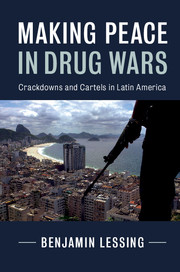Book contents
- Frontmatter
- Dedication
- Contents
- Figures
- Tables
- Preface
- Acknowledgments
- Abbreviations and Acronyms
- 1 Introduction
- PART I A THEORY OF CARTEL–STATE CONFLICT
- 2 What Is Cartel–State Conflict?
- 3 Logics of Violence in Cartel–State Conflict
- 4 Modeling Violent Corruption and Lobbying
- PART II CASE STUDIES
- PART III CONDITIONAL REPRESSION AS OUTCOME
- Appendix A Violent-Event Data
- Appendix B List of Interview Subjects
- Bibliography
- Index
- Miscellaneous Endmatter
4 - Modeling Violent Corruption and Lobbying
from PART I - A THEORY OF CARTEL–STATE CONFLICT
Published online by Cambridge University Press: 17 November 2017
- Frontmatter
- Dedication
- Contents
- Figures
- Tables
- Preface
- Acknowledgments
- Abbreviations and Acronyms
- 1 Introduction
- PART I A THEORY OF CARTEL–STATE CONFLICT
- 2 What Is Cartel–State Conflict?
- 3 Logics of Violence in Cartel–State Conflict
- 4 Modeling Violent Corruption and Lobbying
- PART II CASE STUDIES
- PART III CONDITIONAL REPRESSION AS OUTCOME
- Appendix A Violent-Event Data
- Appendix B List of Interview Subjects
- Bibliography
- Index
- Miscellaneous Endmatter
Summary
To clarify and analyze the central causal logics of my theory, this chapter presents game-theoretic models of violent corruption and violent lobbying. Violent lobby- ing can be captured by a very simple war-of-attrition framework—a “toy” model of a dispute over de jure policy between cartels and state leaders; adding sufficient incomplete information generates violence in equilibrium. Violent corruption, however, involves a principal-agent problem between leaders and state enforcers, yielding counterintuitive dynamics. Conventional wisdom treats corruption and confrontation as strategic substitutes; this ignores the complementary role that violent threats play during bribe negotiation. In equilibrium, the likelihood and size of bribes depends on what cartels do if no agreement is reached: either “hiding”—taking evasive actions to reduce loss—or “fighting”—employing vio- lence that may physically reduce losses but also inflicts pain on enforcers. For that reason, I develop a more in-depth sequence of models that provide two important contributions. First, baseline models of “hiding” and “fighting” responses by cartels provide a framework for conceptualizing and mapping the set of possible outcome scenarios: ideal-type scenarios where bribery never occurs (“Peaceful” and “Violent Enforcement”) or always occurs (“State-Sponsored Protection” and “Coerced Peace”), and more realistic “Hide-and-Bribe” and “Fight-and-Bribe” scenarios. Second, by endogenizing cartels’ choice of strategy, a richer version of the model explores how state policy choices interact with parameter conditions to determine which scenario occurs in equilibrium. State crackdowns, I find, can yield both incremental and sudden increases in anti-state violence when (a) corruption is sufficiently rampant, and (b) repression is insufficiently conditional.
A MODEL OF VIOLENT CORRUPTION
Introduction: Crackdowns in Corrupt Contexts
If you want a quick and dirty measure of police corruption, ask a taxi driver “If a cop pulled you over, would you offer a bribe?” In low-corruption settings like Northern Europe, Japan, and much of the United States, the answer is probably “No way.” This is how law enforcement is supposed to work: when police catch an infractor, neither side even considers bribery a real possibility, and the law is always enforced.
- Type
- Chapter
- Information
- Making Peace in Drug WarsCrackdowns and Cartels in Latin America, pp. 82 - 118Publisher: Cambridge University PressPrint publication year: 2017



